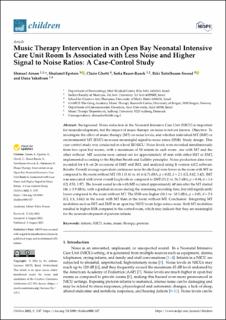| dc.description.abstract | Background: Noise reduction in the Neonatal Intensive Care Unit (NICU) is important for neurodevelopment, but the impact of music therapy on noise is not yet known. Objective: To investigate the effect of music therapy (MT) on noise levels, and whether individual MT (IMT) or environmental MT (EMT) increases meaningful signal-to-noise ratios (SNR). Study design: This case-control study was conducted in a level III NICU. Noise levels were recorded simultaneously from two open bay rooms, with a maximum of 10 infants in each room: one with MT and the other without. MT sessions were carried out for approximately 45 min with either IMT or EMT, implemented according to the Rhythm Breath and Lullaby principles. Noise production data were recorded for 4 h on 26 occasions of EMT and IMT, and analyzed using R version 4.0.2 software. Results: Overall average equivalent continuous noise levels (Leq) were lower in the room with MT as compared to the room without MT (53.1 (3.6) vs. 61.4 (4.7) dBA, p = 0.02, d = 2.1 (CI, 0.82, 3.42). IMT was associated with lower overall Leq levels as compared to EMT (51.2 vs. 56.5 dBA, p = 0.04, d = 1.6 (CI, 0.53, 1.97). The lowest sound levels with MT occurred approximately 60 min after the MT started (46 ± 3.9 dBA), with a gradual increase during the remaining recording time, but still significantly lower compared to the room without MT. The SNR was higher (18.1 vs. 10.3 dBA, p = 0.01, d = 2.8 (CI, 1.3, 3.86)) in the room with MT than in the room without MT. Conclusion: Integrating MT modalities such as IMT and EMT in an open bay NICU room helps reduce noise. Both MT modalities resulted in higher SNR compared to the control room, which may indicate that they are meaningful for the neurodevelopment of preterm infants. | en_US |

